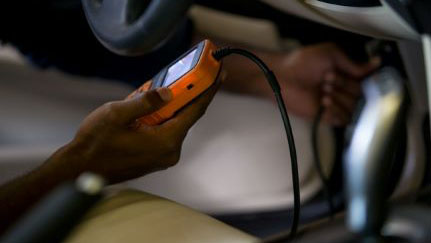What is checked during a vehicle safety inspection?

You’re entering hour six of that 12-hour jaunt down the coast, cruising down the interstate, not a care in the world, and then, out of nowhere, your car starts to rattle. Suddenly, your arrival time is in serious jeopardy.
Of course, this is a fictional tale, because, like any good car owner, you regularly take your car in for inspection. But what is checked during a car safety inspection? A vehicle safety inspection covers all the features of your car that make it safe to drive on the road. That means checking your tires, brakes, lights, mirrors, and things your vehicle needs to function properly to keep you and your fellow drivers safe. So unless you’d like to learn what to do when your car breaks down, let’s get into the finer points of passing a vehicle safety inspection.
What is a vehicle safety inspection?
It varies depending on what state you’re in, but generally speaking, a vehicle safety inspection is a government inspection that ensures vehicles are safe for the road. Some states require this inspection annually, while others only require it before the sale of a vehicle, so always be sure to familiarize yourself with your state’s vehicle inspection laws. Many states also include an emissions test with each inspection to check if your vehicle is up to date with current EPA emissions standards.
What is included in a vehicle safety inspection?
Vehicle safety inspections are performed by licensed car technicians at any of your state’s DMV locations. These technicians run your car through a checklist of features that must be functioning properly to be considered safe. That includes visibility features like your lights, horn and mirrors, your steering and brakes, seatbelts, and your tires. Technicians will check for any obvious hazards like fuel leaks too, the presence of which can be grounds for inspection failure.1
Here is a list of what’s checked during an inspection:
Tires
Tires are checked to determine if the tread has been worn down or if any hazardous defects are present such as dry rot, bubbles, or other damage. The technician will also check your spare tire to ensure it is road-ready should you ever need it.
Brakes
Functioning brakes are one of the most fundamental car inspection requirements. The technician will check to see if the brake pads and rotors are excessively worn and also if there are any brake fluid leaks. The emergency brake (or parking brake) will also be checked. If your brakes have been feeling “squishy” or otherwise slow to respond, you should consider having them checked or you may not pass the inspection.
Lights
Being able to see and be seen on the road is crucial to operating your vehicle safely. Every vehicle safety inspection will include a check of your headlights, taillights, hazard lights, turn signal, license plate lights, and brake lights. All of these lights must function properly without being too dim.
Windshield
Inspections often include a windshield assessment that ensures your view isn’t obstructed and checks for any cracks, chips, or loose seals that could lead to larger problems later.
Windshield Wipers
Your windshield wipers may be checked along with your windshield to make sure they aren’t streaking or otherwise failing to keep your windshield clear. It’s worth noting that your vehicle does need windshield wipers to pass inspection.
Mirrors
Without your rear and side view mirrors, you’re effectively driving your vehicle with 180 degrees of blindness. If you can’t see what’s coming up behind you, you’ll have no idea when it’s safe to change lanes or get out of harm’s way, if and when it’s necessary. Both your side view mirrors and your rearview must be present and undamaged to pass inspection.
Seat belts
Your seat belts’ ability to auto-lock and retract will be checked during the inspection to ensure your seat belts are functioning safely.
Steering and alignment
Your steering components will all be checked during inspection to ensure that nothing is loose or in danger of failing. Any instance of steering failure during a turn could be disastrous, so any worn parts identified during the inspection could result in failure of the inspection.
Suspension
Your suspension is what gives you a smooth ride as your vehicle traverses the bumpy, uneven roads of the world. The inspection technician will check to make sure none of your shock absorbers are leaking or otherwise damaged.
Inspect your car regularly
With so many potential problems, it’s always best to take your vehicle in regularly for inspection, even if your state doesn’t require it. There are national car care months in April and October to bring extra attention to the importance of these safety checks, so take advantage of these opportunities to get your inspection done. April is an excellent time to take care of any damage or wear your vehicle sustained during the winter and prepare for summer road trips, while October is a great time to make sure you’re prepared for the coming winter.2
By observing safe driving protocols and taking your vehicle in for regular inspection, you can make the road a much safer place to be. Accidents happen though, and it’s always best to be prepared. Discover auto insurance resources to learn about the best coverage options for keeping you, your car, and your wallet safe.